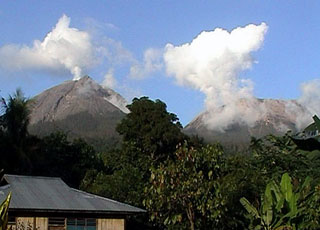Report on Lewotobi (Indonesia) — 3 January-9 January 2024
Smithsonian Institution / US Geological Survey
Weekly Volcanic Activity Report, 3 January-9 January 2024
Managing Editor: Sally Sennert.
Please cite this report as:
Global Volcanism Program, 2024. Report on Lewotobi (Indonesia) (Sennert, S, ed.). Weekly Volcanic Activity Report, 3 January-9 January 2024. Smithsonian Institution and US Geological Survey.
Lewotobi
Indonesia
8.542°S, 122.775°E; summit elev. 1703 m
All times are local (unless otherwise noted)
PVMBG reported that the eruption at Lewotobi’s Laki-laki volcano from a fissure on the upper NNW flank and from a vent on the upper SSE flank was ongoing during 3-9 January. White plumes rose 300-1,000 m above the summit and drifted SW and W during 3-5 December. During the rest of the week white-and-gray or gray-to-brown ash plumes rose 1-1.5 km above the summit and drifted NW, N, and NE. The ash plumes were sometimes dense.
Masks had been distributed in Hokeng Jaya, Pululera, Klatanlo, and Nawakote in the district of Wulanggitan and the village of Dulempari in the district of Bura after the eruption began in late December and residents were encouraged to wear them when outside to minimize ash inhalation. On 1 January as many as 1,185 residents of Boru Village and 328 residents in the Konga Village area self-evacuated to several other locations including relatives’ homes and evacuation posts. Ash fell in several areas in the Wulanggitan and Bura districts. Badan Penanggulangan Bencana Daerah (BPBD) East Flores Regency mobilized and provided residents with essentials including mobile kitchens, food, tents, and cleaned ash off roadways. By 4 January a total of 3,898 people had evacuated. The Frans Xavier Seda Airport in Sikka District closed on 1 January due to thick ash deposits on the runways; it remained closed as of 9 January.
Activity intensified during the evening of 9 January. Incandescent material was ejected from the summit and lava flows from the NNW-flank fissure descended the NW flank. At 2300 the Alert Level was raised to 4 (on a scale of 1-4) and the public was warned to stay 4 km away from the Perempuan and Laki-laki craters and an additional 5 km from the NNW flanks of Laki-laki.
Geological Summary. The Lewotobi edifice in eastern Flores Island is composed of the two adjacent Lewotobi Laki-laki and Lewotobi Perempuan stratovolcanoes (the "husband and wife"). Their summits are less than 2 km apart along a NW-SE line. The conical Laki-laki to the NW has been frequently active during the 19th and 20th centuries, while the taller and broader Perempuan has had observed eruptions in 1921 and 1935. Small lava domes have grown during the 20th century in both of the summit craters, which are open to the north. A prominent cone, Iliwokar, occurs on the E flank of Perampuan.
Sources: Pusat Vulkanologi dan Mitigasi Bencana Geologi (PVMBG, also known as CVGHM), Badan Nacional Penanggulangan Bencana (BNPB), Badan Penanggulangan Bencana Daerah Provinsi Jawa Timur (East Java BPBD), Directorate General Of Civil Aviation, Ministry Of Transportation Republic Of Indonesia

